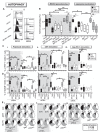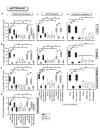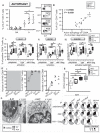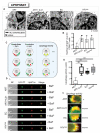Lipophagy confers a key metabolic advantage that ensures protective CD8A T-cell responses against HIV-1
- PMID: 33459125
- PMCID: PMC8632342
- DOI: 10.1080/15548627.2021.1874134
Lipophagy confers a key metabolic advantage that ensures protective CD8A T-cell responses against HIV-1
Abstract
Although macroautophagy/autophagy has been proposed as a critical defense mechanism against HIV-1 by targeting viral components for degradation, its contribution as a catabolic process in providing optimal anti-HIV-1 immunity has never been addressed. The failure to restore proper antiviral CD8A/CD8 T-cell immunity, especially against HIV-1, is still the major limitation of current antiretroviral therapies. Consequently, it is of clinical imperative to provide new strategies to enhance the function of HIV-1-specific CD8A T-cells in patients under antiretroviral treatments (ART). Here, we investigated whether targeting autophagy activity could be an optional solution to make this possible. Our data show that, after both polyclonal and HIV-1-specific activation, CD8A T-cells from ART displayed reduced autophagy-dependent degradation of lysosomal contents when compared to naturally HIV-1 protected elite controllers (EC). We further confirmed in EC, by using specific BECN1 gene silencing and lysosomal inhibitors, the critical role of active autophagy in superior CD8A T-cell protection against HIV-1. More importantly, we found that an IL21 treatment was effective in rescuing the antiviral CD8A T-cell immunity from ART in an autophagy-dependent manner. Finally, we established that IL21-dependent rescue occurred due to the enhanced degradation of endogenous lipids via autophagy, referred to as lipophagy, which fueled the cellular rates of mitochondrial beta-oxidation. In summary, our data show that autophagy/lipophagy can be considered as a therapeutic tool to elicit functional antiviral CD8 T-cell responses. Our results also provide additional insights toward the development of improved T-cell-based prevention and cure strategies against HIV-1.Abbreviations: ART: patients under antiretroviral therapy; BaF: bafilomycin A1; BECN1: beclin 1; CEF: cytomegalo-, Epstein-Barr- and flu-virus peptide pool; Chloro.: chloroquine; EC: elite controllers; FAO: fatty acid beta-oxidation; HIVneg: HIV-1-uninfected control donors; IFNG/IFN-γ: interferon gamma; IL21: interleukin 21; MAP1LC3/LC3: microtubule associated protein 1 light chain 3; PBMC: peripheral blood mononuclear cells; SQSTM1: sequestosome 1; ULK1: unc-51 like autophagy activating kinase 1.
Keywords: Antiretroviral therapy; FAO; HIV-1; IL21; elite controllers; lipophagy; polyfunctionality.
Conflict of interest statement
No potential conflicts of interest were disclosed.
Figures







References
-
- Angin M, Volant S, Passaes C, et al. Metabolic plasticity of HIV-specific CD8(+) T cells is associated with enhanced antiviral potential and natural control of HIV-1 infection. Nat Metab. 2019;1:704–716. - PubMed
Publication types
MeSH terms
Substances
LinkOut - more resources
Full Text Sources
Other Literature Sources
Research Materials
